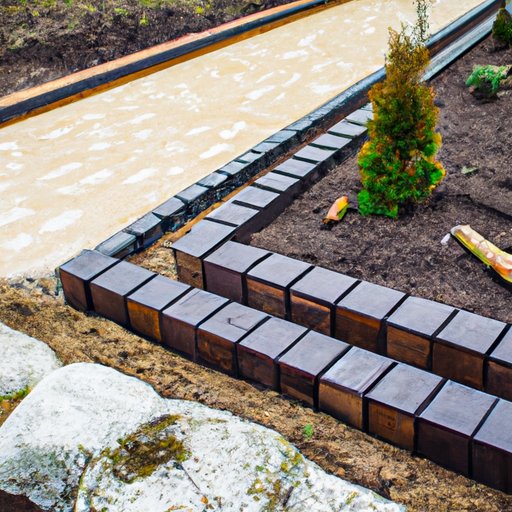Introduction
Edging is the process of defining the boundaries of a flower bed using materials such as rocks, bricks, wood, or metal. It serves to make flower beds look more attractive and also helps to contain soil and keep weeds from spreading into other areas of the garden or landscape. Edging can be a simple DIY project, or it can be done professionally for a more polished look.
Choose the Right Edging Material
When choosing an edging material, there are a variety of options available. These include rocks or stones, pavers or precast concrete blocks, plastic or metal edging, and even logs. Each type of material has its own benefits and drawbacks, so it’s important to consider all of your options carefully before making a decision.
Prepare the Soil and Install the Edging
Once you’ve chosen the right edging material, it’s time to prepare the soil and install the edging. First, use a shovel or spade to dig a trench along the edge of the flower bed. The depth of the trench should be at least 2-3 inches, depending on the type of edging material you’ve chosen. Once the trench is dug, fill it with gravel or sand to create a solid base for the edging material.
Next, start installing the edging material. If you’re using rocks or stones, be sure to place them firmly in the ground, pressing down on each one to ensure it is secure. If you’re using pavers or precast concrete blocks, you may need to use mortar to ensure they stay in place. For plastic or metal edging, simply use a mallet to tap the pieces into the ground.

Create an Attractive Edge with Rocks or Stones
Rocks or stones are a popular choice for edging flower beds. They are easy to install and come in a variety of shapes, sizes, and colors. When selecting rocks or stones, look for ones that are uniform in size and shape, and avoid large rocks, which can be difficult to work with. Be sure to lay the stones in a single layer, so that they fit together snugly.
To ensure that the rocks or stones stay in place, use a small hand tamper to press them into the ground. This will help to prevent them from shifting over time. You can also use a rubber mallet to gently tap the stones into place. Finally, use a garden hose to rinse off the stones and remove any dirt or debris.

Use Pavers or Precast Concrete Blocks
Pavers and precast concrete blocks are another popular option for edging flower beds. They are durable and long-lasting, and come in a variety of styles and colors. However, they can be expensive and require more labor to install than other types of edging materials. When installing pavers or precast concrete blocks, you may need to use mortar to ensure that they stay in place.
When selecting pavers or precast concrete blocks, look for ones that are uniform in size and shape. Also, be sure to lay them in a single layer, so that they fit together snugly. Finally, use a rubber mallet to gently tap the pieces into place.
Plant Low-Growing Ground Cover Plants
Low-growing ground cover plants, such as creeping thyme or Irish moss, can be used to edge flower beds. These plants are low-maintenance and add a soft, natural touch to the garden. When selecting ground cover plants, look for ones that are suited to your climate and growing conditions. Some plants may require more sunlight or water than others, so be sure to read the plant labels carefully before making a purchase.
When planting ground cover plants, be sure to dig a shallow trench along the edge of the flower bed. Fill the trench with soil, then plant the ground cover plants in the soil. Gently press down on each plant to ensure it is secure. Water the plants regularly, and mulch around them to help retain moisture and discourage weeds.
Create a Log Edging
If you’re looking for a rustic touch, consider creating a log edging for your flower bed. Logs are easy to install and will add a unique, natural look to your garden. When selecting logs, look for ones that are uniform in size and shape, and avoid large logs, which can be difficult to work with.
To install the logs, dig a shallow trench along the edge of the flower bed. Place the logs in the trench, making sure they are level and secure. Use a rubber mallet to gently tap the logs into place. Finally, use a garden hose to rinse off the logs and remove any dirt or debris.

Install Plastic or Metal Edging
Plastic or metal edging is a great option if you’re looking for a quick and easy solution. These edging materials are lightweight and easy to install, and come in a variety of styles and colors. When selecting plastic or metal edging, look for ones that are designed for outdoor use and are resistant to rust and corrosion.
To install the edging, simply use a mallet to tap the pieces into the ground. Be sure to leave enough space between each piece to allow for expansion and contraction due to temperature changes. Finally, use a garden hose to rinse off the edging and remove any dirt or debris.
Conclusion
Edging flower beds can be an effective way to give your garden or landscape an attractive and professional look. By choosing the right edging material and following the steps outlined above, you can easily edge your flower bed and add a finishing touch to your garden.


